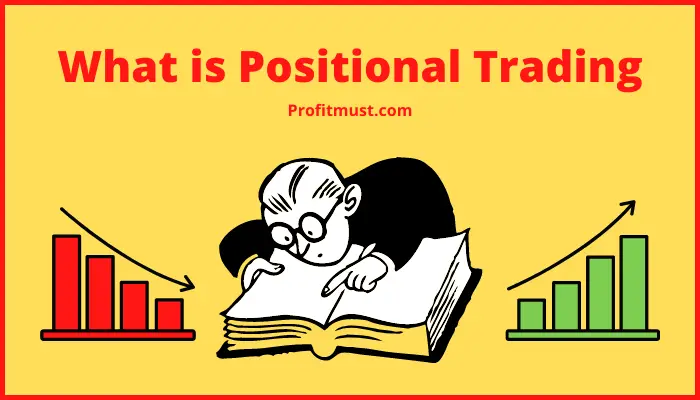You’ve probably heard of positional trading during your stock market trading career. Positional trading may be perfect for you if you want to trade in the stock market but the intraday fluctuations are too quick for you and you don’t want to lock your money up in a long-term commitment. Let’s understand what is positional trading means and it’s it suitable for you?
Table of Contents
Introduction
Positional trading is a type of intraday trading that allows you to keep your positions open overnight for a day, weeks, or even months. You don’t have to be a full-time trader or spend your days hooked to the computer like an intraday trader.
Positional trading is a great way to get your feet wet in the stock market without having to deal with the pressure of intraday trading. Nevertheless, it is important to note that no stock market investment or trading is without risks.
Every trade has its own range of threats, and it is essential to be aware of all of them before making a decision.
What is Positional Trading Means?
Positional Trading is a popular trading method that enables a trader to keep and continue his holding in the share market for a longer length of time. This time frame can be a single day, a week, or even a month.Positional traders ignore short-term market changes in favor of identifying and gaining from longer-term market trends.
Positional trading is quite similar to investing, with the exception that buy and hold investors are bound to just going long. Let’s take a look at a few of the most popular positional trading approaches.
Positional Trading Strategies
After You know Positional Trading means, let’s take a look at it’s Strategies. It entails applying technical and basic research to assess possible price patterns in the market. The following are some of the most often used positional trading strategies:

-
50 DMA Trading
The 50-Day Moving Average Indicator is among the most important indicators in positional trading. The moving averages of major long-term patterns are represented by 50, which is a factor of both 100 and 200.
When the 50-Day Moving Average indicator crosses the 100 and 200-Day Moving Average indicators, it could signal the beginning of a new long-term trend, making it a useful indication for positional traders.
-
Support and Resistance
In the stock markets, support and resistance zones are significant because they reflect the direction of a stock’s price action. Positional traders can use this information to decide whether to open or close a position on that asset. For this approach, to operate the trader must first recognize and review chart patterns.
The prior support and resistance zones are frequently used to predict future ones. It’s a typical incident for a resistance level to become the future support level when it’s broken. Many Technical indicator Software also offer active support and resistance levels.
-
Breakouts
Trading breakouts are among the most popular and effective approaches for positional traders since they signal the start of the next significant market swing. It assists positional traders in entering a trade at the start of a trend.
Breakout arises when the price of an equity moves beyond the pre-defined support and resistance levels. It is necessary to understand how to recognise moments of support and resistance in order to apply a trading breakouts strategy.
-
Pullback and Reversal Method
A pullback occurs when the current price direction of an equity reverses for a brief period of time. Positional traders that utilise the pullback and reversal method try to profit from these market interruptions.
The basic goal of this strategy is to buy at a cheaper price and sell at a premium price before the price falls, and then purchase at the next low price.
It not only assists positional traders in booking profits in long-term trends, but it also assists them in eliminating market losses.

Advantage of Positional Trading
Positional trading can be a wonderful trading technique if a trader applies the following approaches with the relevant experience and understanding. The key advantage of positional trading is that it allows you to use a variety of trading approaches.
Positional trading allows you to practise intraday and swing trading based on market patterns. Positional trading also allows you to take advantage of large stock fluctuations over weeks and months.
Another of the key benefits of it, which makes it a wonderful alternative to Intraday trading, is that you may perform all of this without spending the entire trading session dedicated to the computer.
It takes very little time if you have a trading strategy that is based on thorough analysis.
Disadvantage of Positional Trading
Market investments are loaded with threats. It’s the same with this trading style. It comes with its own set of risks. Limited liquidity and trend reversal threats are two of the most common concerns.
The positional trader suffers significant losses whenever there is a sudden reversal in the trend of a stock ‘s price Positional trading also necessitates the investor’s capital being locked up for a longer length of time.
Before entering into the area of positional trading, it’s a good idea to get your risk profile reviewed. After Positional Trading Means let’s Understand Position trader.
What is a Position Trader?
A position trader buys an investment with the anticipation of it increasing in value over time. Short-term price changes and the news of the day are less important to this type of trader until they change the trader’s long-term view of the position.
Day traders are the complete opposite of position traders. They don’t trade frequently & execute a few trades per year.

Understanding a positional Trader
By nature, trend followers are position traders. Their fundamental idea is that once a trend begins, it will almost certainly persist for some time. Position traders can be differentiated from buy-and-hold investors, who are considered passive investors who keep their positions for even longer durations than position traders.
The buy-and-hold investor is constructing an asset portfolio for a long-term purpose, such as retirement. The position trader has identified a trend, purchased it, and is now waiting for it to peak before selling.
This trading theory aims to profit from the majority of a trend’s upward movement. As a result, it is fundamentally opposed to day trading, which aims to profit from short-term market changes.
Are you a positional Trader?
Investors and traders must fit their trading strategies to their specific objectives, and every approach has its own set of advantages and disadvantages. The first thing to think about is why you’re investing in the first place.
Are you putting money down for the future? Do you intend to trade for a living? Or do you truly enjoy participating in the stock market and want a piece of the action? And how much time do you want to spend analyzing your portfolio every week or every day?
A bull market with a positive trend is great for position trading. It does not simply adapt itself to a bear market. Day trading may be advantageous during periods when the market is flat, going sideways, or simply spins across.
Conclusion
If you want to trade in the stock but don’t have the time to be a full-time intraday trader, positional trading may be the way to go. If you trade with appropriate skills and analysis, It might be a fantastic option to intraday trading.
This is all from our side regarding position trading strategy. Let us know your views about positional trading meaning in the comment section.
Other Interesting blogs related to Is positional trading meaning:
Difference between Nifty and Sensex
Best Books For Stock Market Beginners in India
FAQ About Position Trading Strategies
Positional Trading meaning in hindi?
पोजिशनल ट्रेडिंग एक लोकप्रिय ट्रेडिंग पद्धति है जो एक ट्रेडर को शेयर बाजार में अपनी होल्डिंग को लंबे समय तक बनाए रखने और जारी रखने में सक्षम बनाती है। यह समय सीमा एक दिन, एक सप्ताह या एक महीने की भी हो सकती है।
Positional trading strategy
50 DMA Trading, Support & Resistance, Trading breakouts and Pullback & Reversal Method are some popular Positional trading strategies.
Position trading for Beginners?
50 DMA Trading, Support & Resistance, Trading breakouts and Pullback & Reversal Method are some popular Positional trading strategies which Beginners can use while trading with a small amount in starting.
Short-term positional trading?
Short-term trading requires taking a position for a short period of time, ranging from seconds to days. It's employed as a substitute for the more typical buy-and-hold strategy, which involves holding a position for weeks, months, or even years.
Positional trading Zerodha?
Yes, you can do Positional trading in Zerodha & the Charges will be the same as delivery trading.

